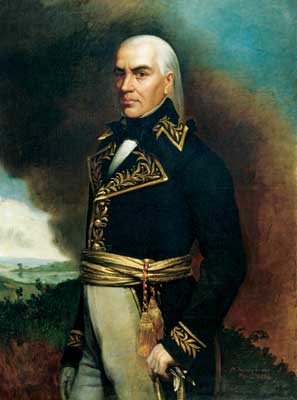Most Interesting Eighteenth-Century Life: Francisco de Miranda September 11, 2016
Author: Beach Combing | in : Modern , trackback
It would be futile to discuss which historical man or woman had the most interesting life: what, after all, is ‘interesting’? However, if we think of places visited and people met, then a good candidate is surely Francisco de Miranda (1750-1816), South American patriot, playboy, soldier, sexual athlete and general n’er-do-well. Consider, just as a taster, his geographical slime-trail. De Miranda’s family came from the Canaries off the African coast and Francisco himself was born in Caracas in Venezuela. He travelled, predictably enough, to Spain. He joined the Spanish army and fought in Northern Africa, then Cuba and Florida and the Bahamas, visiting other parts of the Caribbean including Jamaica. He travelled through all of what was then the United States for a year: a rather smaller version than the US we know today. He later travelled through Europe, managing a particularly stimulating and dangerous version of the grand tour. In that time he visited Belgium, France, Norway, Germany, Russia, Poland, Hungary, Greece and Italy, to name only the highlights, a period that lasted about twenty years. He afterwards joined the revolutionary army in France (God help us) and fought in Belgium. He then headed to Britain where he married and lived for many years in London. He returned to the US trying to drum up support for his failed attempts to ‘liberate’ Spanish America: Beach has put in the inverted commas because not many of the Spanish Americans seem to have been interested in ‘liberation’, at least not at this date. Then, he ended his life in a Spanish prison after having gone backwards and forwards across the Atlantic a half dozen times.
It is true that in an age of empires many others, perhaps sometimes even common soldiers, had similarly impressive itineraries. Imagine where a British tommy might have gone from 1830-1850, say. However, what makes de Miranda’s tour so impressive is the extraordinary number of great men and women he met along the way. In some cases this was just the case of an interview: Miranda managed a chat, for example, with Haydn; he seems to have come across James Barry, too. However, often there were long lasting friendships. Francisco de Miranda corresponded with William Wilberforce, Alexander Hamilton and James Mill, for example. He slept with Catherine the Great: or at least he claimed to have – she made him a Russian count. (Miranda bedded perhaps every third woman he met). He served with Napoleon, who sensibly never trusted the American. When he was arrested, as the French revolution began to eat its own children, Thomas Payne wrote a defence and de Miranda’s lawyer was the brilliant Claude François Chauveau-Lagarde, who was, later, to defend Marie Antoinette. He talked history with Edward Gibbon and the Abbé Raynal. He talked war with the Duke of Wellington and Admiral Alexander Cochrane, the Marquis de Lafayette and Thomas Jefferson. He spoke politics with William Pitt, George Washington, Frederick II, James Madison, James Monroe, John Adams, Alexander Hamilton and James Madison. He mentored, meanwhile, at his house in London, Simón Bolívar, Andrés Bello and Luis López Méndez. And so the list goes on through much of the A and B celebrity lists of the 1700s.
Again, an aristocrat in the mid eighteenth century might have met many of these men and women in the course of a diplomatic career. But Francisco de Miranda was the son of a despised new world merchant. He should never, by the laws of eighteenth-century society, have come close to most of these individuals save perhaps to black their shoes. Yet de Miranda could have recalled, in his Spanish cell at the end of his life, the blue veins on Catherine the Great’s breasts, Napoleon unpleasant breath and William Wilberforce’s slight stutter. It is the enlightenment version of ‘I’ve seen things you people wouldn’t believe. Attack ships on fire off the shoulder of Orion etc etc’ As with so many of these voracious, magnetic human beings there is the suspicion that it may have been better had Francisco de Miranda never lived. One of the tragedies of world history is that the Spanish Americas followed the example of the French rather than the American revolution and de Miranda was instrumental in this. But if you wanted to bring back one eighteenth-century figure from the dead to ask him about his contemporaries, it would probably be Francisco de Miranda. Imagine what a three-hour documentary that would make… Other interesting lives: drbeachcombing At yahoo DOT com


